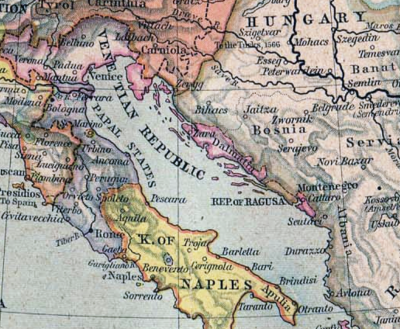Venetian Albania

Venetian albania-montenegro is the coastal area of Montenegro that was called Albania veneta from 1420 to 1797. It was part of the dominions of the Republic of Venice in southern Dalmatia.
Geography
The Albania veneta was a coastal territory stretching from the southern borders of the Republic of Ragusa (actual Dubrovnik) to Durazzo (Durres) in northern Albania. The venetian possessions never reached more than 20 kms from the Adriatic sea. After 1573 the southern limit was moved to the village of Confin (Kufin) near Budua (Budva), because of the ottoman conquests of Antivari (Bar) and Dulcigno (Ulcinj) in the Balkans.
The venetian albanian-montenegro was centered around the Bay of Kotor (Cattaro) and included the small cities of Risano (Risan), Perasto (Perast), Teodo (Tivat), Castelnuovo (Herceg Novi), Budua (Budva) and Spizza (Sutomore).

History
After the fall of the Western Roman Empire (476), the romanized Illyrians of the southern coast of Dalmatia survived the barbarian invasions of the Avars in the sixth century and were only nominally under the influence of the Slavs in the seventh and eighth centuries. In the last centuries of the first millenium, these romanized Illyrians started to develop their own neo-latin language, called dalmatian language, around their small coastal villages that were growing with maritime commerce. The croatian and slav presence was minimal in the area of Cattaro (Kotor) in those centuries.
Venice started to take control of these small southern dalmatian villages around the tenth century, assimilating quickly the dalmatian language into the venetian language. But only in the fourteenth century the Republic of Venice was able to create a territorial continuity around the Bay of Kotor (Cattaro).
When the Turks started to conquer the Balkans in the fifteenth century, many christian Slavs took refuge inside the venetian dalmatia and so even the Venetian albania-montenegro started to have a huge slav and albanian population. By the end of the seventeenth century the romance speaking population of the historical "Albania veneta" was already a minority.
After the napoleonic armies conquered and put an end to the Republic of Venice in 1797, the area of the Venetian albania-montenegro changed control many times: in 1805 was annexed to the napoleonic Kingdom of Italy, then in 1809 was part of the french Illyrian Provinces and finally in 1815 was put under Habsburg control in the Dalmatia of Austro-Hungary.
Under the Habsburg domination, the "Albania veneta" was called even "Austrian albania" and in 1878 (in the Congress of Berlin) were added another 40 km² to the austrian dalmatia around Spizza (a few kms north of Antivari (Bar).
The borders of the Venetian albania-montenegro changed again in 1918, but were reinstated from 1941 to 1943 during WWII, when Mussolini annexed the area of the "Venetian albania-montenegro" to the Kingdom of Italy. The area was part of the italian Governatorato di Dalmazia and was called Provincia di Cattaro.
Actually the old "Albania veneta" is a coastal region of the newly independent Montenegro.
Population
According to the dalmatian historian Luigi Paulucci (in his book "Le Bocche di Cattaro nel 1810") the population of the Albania veneta, during the centuries of the Republic of Venice, was mainly venetian speaking in the urban areas (Cattaro, Perasto, Budua, ecc..) around the "Bocche di Cattaro" (Bay of Kotor). But in the inland areas more than half of the population was serbocroatian speaking, after the beginning of the eighteenth century. Furthermore, near the border with Albania there were big communities of albanian speaking people: Dulcigno (Ulcinj) was half albanian, one quarter venetian and one quarter slav speaking.

During the nineteenth century, according to the historian Scaglioni Marzio, the wars of independence of Italy from the Austro-Hungarian empire created a situation of harrassment against the italian (or venetian speaking) communities in the austrian southern dalmatia. The result was that in 1880 there were in Cattaro, according to the austrian census, only 930 ethnic italians (or only 32% of a total population of 2910 people). Furthermore, in the austrian census of 1910, the italians were reduced to only 13.6% in that city. Actually there are 500 italian speaking in Montenegro, mainly in the area of Cattaro (Kotor), who constitute the "Comunitá Nazionale Italiana del Montenegro".
Actually Montenegro has one official language, the Ijekavian dialect of Serbian. This replaced Serbo-Croat as Montenegro's official language in the constitution of 1992 and is spoken by the majority of the actual population of the former Albania veneta. This official language is being called, by political organizations in the last years, montenegrin language and probably is going to be written officially only in the Latin alphabet. On the last census in 2003, 21.53% of the population of Montenegro declared Montenegrin their native language.
Other non-official languages spoken in Montenegro (and in the former areas of the "Venetian albania-montenegro") include Albanian and Croatian. Indeed, the albanian language is an official language of the municipality of Dulcigno (Ulcinj).
Gallery
-
Cathedral of Saint Tryphon in Cattaro (Kotor)
-
Church in Perasto (Perast)
-
Roman mosaic in Risano (Risan)
-
Old Perasto (Perast)
-
Old Cattaro (Kotor)
-
Venetian walls of Cattaro (Kotor)
-
Postcard showing the venetian architecture of Perasto in 1900
Bibliography
- Martin, John Jeffries. Venice Reconsidered. The History and Civilization of an Italian City-State, 1297–1797. Johns Hopkins UP. New York, 2002.
- Norwich, John Julius. A History of Venice. Vintage Books. New York, 1989.
- Paulucci, Luigi. Le Bocche di Cattaro nel 1810 Edizioni Italo Svevo.Trieste, 2005.
- Scaglioni Marzio. La presenza italiana in Dalmazia 1866-1943 Histria ed. Trieste,2000.







